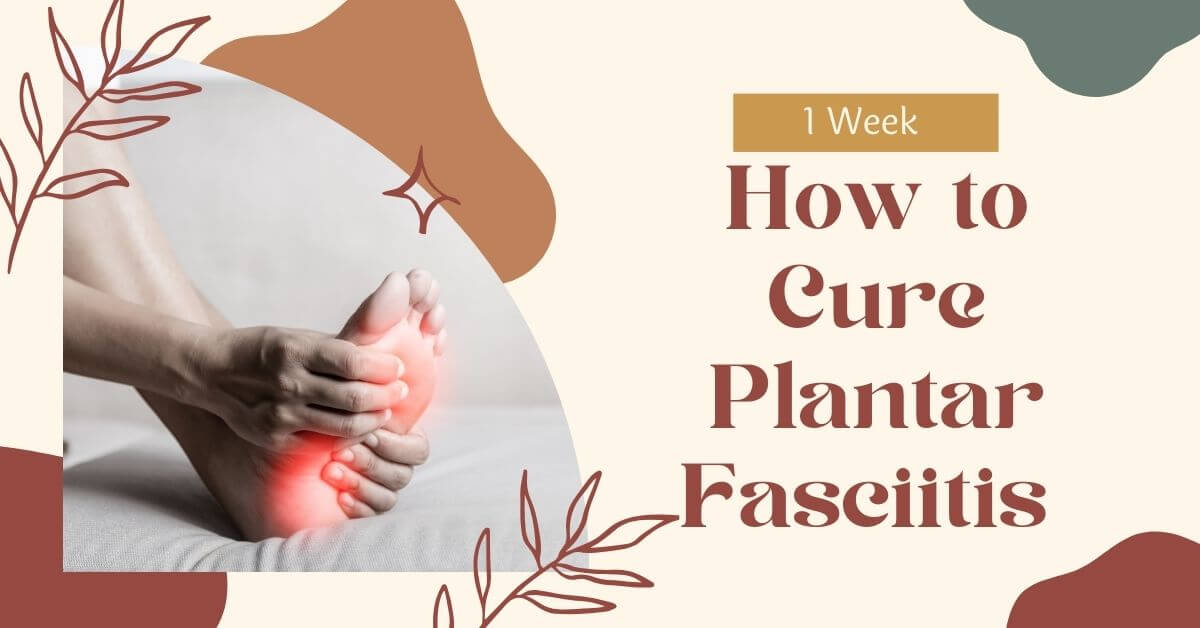Are you having a hard time with plantar fasciitis and desire quick relief? Many other people are also in the same situation. Plantar fasciitis is a condition that can cause pain bottom part of your feet.
I have experienced this pain myself and that’s why I have lined up some remedies for you to try out within a week. You’ll find them here after going through the ones that helped me, and several others too.
Understanding Plantar Fasciitis
The most typical foot problem that causes pain under the heel is called plantar fasciitis.
This happens when the bottom of your foot gets irritated and swells.
In America, lots of people have it. Most frequently, it comes about due to overdoing things like standing for too long or walking for several miles.
This tissue provides support to your foot arches and cushions them from shock. It stretches across the whole length of your sole from the heel to just before you reach the toes.
This problem can be more likely if you have flat feet, high arches, or tight leg muscles.
There are other factors such as obesity, age, and having a job that requires you to stand on your feet most of the time which also increases its chances of occurring.
It would be better if you knew what causes plantar fasciitis so that you can get the correct medication for it. Your life quality will improve significantly if treated properly thus enabling one to feel well again while living with this ailment.
Shoes play a vital role in resolving this problem. Here are some shoe suggestions:
The Best Gym Shoes for Plantar Fasciitis
Best Walking Tennis Shoes for Plantar Fasciitis
Doctor Recommended Shoes Plantar Fasciitis
What are the Symptoms of lantar Fasciitis?
In case you have plantar fasciitis, mostly is a stabbing pain at the bottom of your foot near the heel that you will feel.
On the other hand, the severity of this pain is at its peak during your first steps in the morning and after being on your feet for a long and in an attempt to stand up.
You may feel better moving around but it recurs once you conduct some physical activity.

What Causes Plantar Fasciitis?
The exact cause isn’t always clear, but several factors can increase your risk:
- Age: It is most prevalent between 40 and 60 years old
- Certain types of exercise: Engaging in sports like marathon running, ballet dancing, and aerobics can exert too much pressure on the heel or tissues surrounding it.
- Foot mechanics: Having flat feet, high arches, or an abnormal walking pattern may affect how weight is distributed on your feet by putting extra stress on the plantar fascia.
- Excessive weight: This overweight can put additional pressure on your plantar fascia.
- Occupations that keep you on your feet: Occupations such as teaching or factory work where one has to spend long hours standing contribute to damage to one’s plantar fascia.
Why Does It Hurt So Much?
Plantar fasciitis causes a lot of pain, especially in the morning when you take your first steps.
The pain originates from the irritation and swelling of tissue beneath the foot. It’s like penetrating pain on the heel. This is because although it is attempting to repair itself, repeated tearing and stretching only makes it more painful.
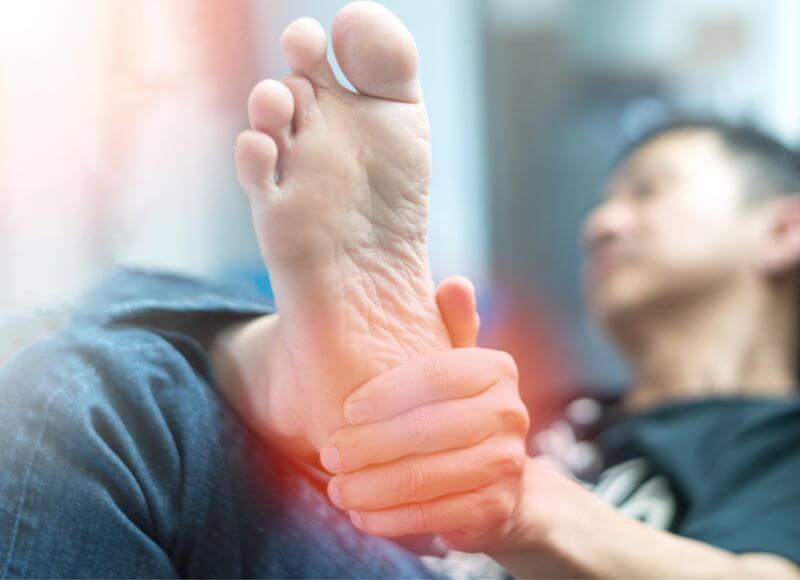
The tissue affected by plantar fasciitis serves crucial purposes such as supporting the arch of your foot as well as shock absorption. When irritated, it can be very uncomfortable.
Although people frequently attribute it to inflammation this is not really true. More often than not, what you will be feeling is a sharp pain in your heel which may sometimes have a hard growth called a heel spur.
Day one: Take a Break and Take Stock
On the first day, take a break from your ordinary activities to give your feet some time off. If you have been on your feet for a long time due to work, fitness, or everyday tasks, then it is high time you rested them.
Avoid things that stress heel or foot pain. It is crucial to rest initially as this jump-starts the process of recovery in your body. Be keen to note where you are having pains or discomforts and also acquaint yourself with what plantar fasciitis symptoms are all about.
RICE: Your Quick Painkiller
This is an abbreviation that stands for Rest, Ice, Compression, and Elevation which when done properly can help reduce foot pain and swelling. Here’s how:
- Rest: There should be no weight put on the leg to allow the healing of the tissues.
- Ice: Apply ice packs 15-20 minutes every few hours during the day over your heel to decrease inflammation and provide analgesia.
- Compression: Use bandages on your injured foot or wear socks that compress thereby providing support for swollen feet.
- Elevation: Raise your foot above heart level whenever possible in order for blood flow to improve as well as reduce swelling.
Consistent adherence to the RICE technique at least in these three days would result in considerable relief and consequently speed up the recovery process.
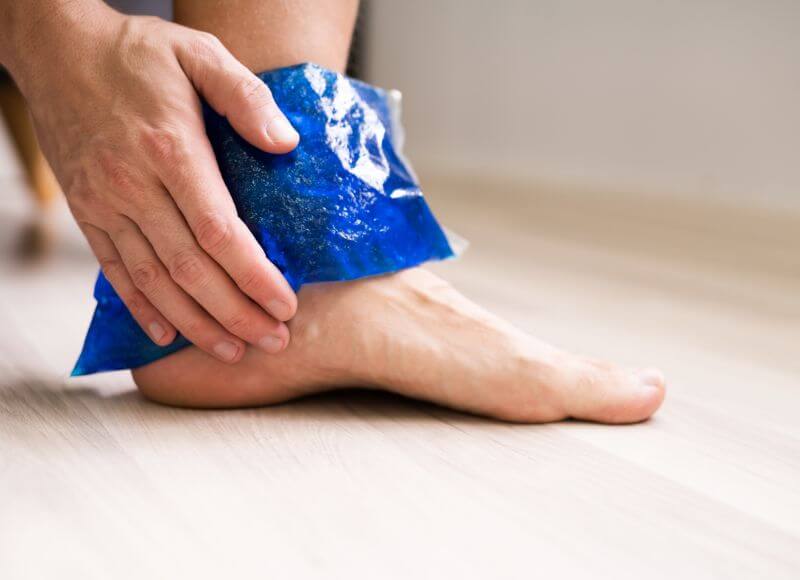
Night Splints: A Helpful Tool for Overnight Relief
The Night splints are tools that hold your foot straight while you sleep. Thus, it allows blood to flow into the area and helps in reducing such pain experienced in the morning.
When on a night splint, the plantar fascia remains elongated hence preventing it from shrinking during the night. This can help reduce symptoms significantly and expedite recovery.
Anti-Inflammatory Medications: A Temporary Solution
Antipyretic medications like naproxen or ibuprofen which are bought over-the-counter may be used to decrease pain as well as swelling.
However, this isn’t a solution that should be relied upon for the long-term use of drugs.
If there are any questions on this one must follow commands given on the bottle and consult a physician when using other medicines. Also, one ought to adopt other treatments alongside this kind of medication for proper relief.
Lifestyle Changes: Small Steps for Big Improvements
Make small changes that can assist your healing process such as:
- Wear good shoes with supportive arches.
- Don’t walk barefoot on hard surfaces.
- Keep your weight under control so as not to stress your feet too much.
- Stretch out your calves and plantar fascia regularly to keep them from getting stiff.
Day 2: Just Relax and Taping Up
Incorporate more cold therapy and use taping techniques to support your foot on day two of your journey to heal from plantar fasciitis.
More Icing/Cold Therapy
Keep on using cold therapy as a priority in order to reduce inflammation and pain in your foot. Many packs of ice or cold compressions can be used for about 15-20 minutes at a time, several times a day.
Do not forget that the ice pack has to be wrapped with a thin towel so that your skin does not come directly into contact with it. Cold treatment makes the area numb, reduces swelling, and speeds up healing; therefore, it is an indispensable part of the recovery process.
Taping Techniques
There are some techniques for taping your foot that can give you extra support to the plantar fascia and reduce pain. Below is how you can do it properly:
- Have a completely clean and dry skin on your foot.
- Select a suitable adhesive such as zinc oxide or Leukotape.
- Begin by securing tape just below the ball of the foot, around the heel, and then back again under the arch.
- Use the tape with enough tension to help in support while not restricting movement.
- Ensure that there are no wrinkles or folds in the tape and it should be smooth as well as secure.
You may check online for step-by-step instructions or consult with a physical therapist who will guide you through tailored taping advice.
Taping may also accompany other treatments like stretching exercises coupled with strengthening exercises, which help add firmness and comfort during the recovery journey.
Day 3: Easing Tension Through Stretching
What Stretching Does
It is very important to stretch your feet and leg muscles in order to heal plantar fasciitis pain.
It will make the muscles flexible, loosen them up, and reduce the pressure exerted on your feet. Doing these exercises at least twice a day can prevent it from getting messed up again.
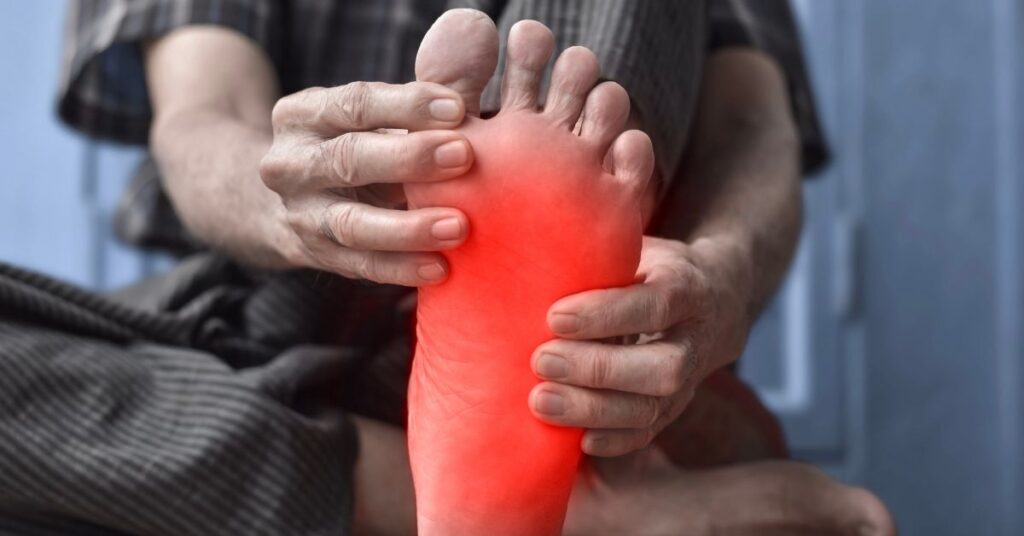
When Stretching Should Be Done
The worst time for you to stretch is in the morning before walking because that’s when the pain is usually experienced most intensely. By stretching your foot and leg muscles gently while still lying on your bed, you can make the pain less severe when you start walking.
How to Stretch Your Plantar Fascia
Try this simple exercise for stretching your plantar fascia:
- Sit down on the floor and keep your legs straight ahead of you.
- Wrap a towel around the ball of the foot with one end held with each hand.
- Gently pull the towel towards yourself while moving your toes back towards you until a pulling is felt along the soleus and bottom of your foot.
- Hold it for 15-30 seconds then let go.
- Do another 2-3 repetitions alternating between both feet.
Remember to stretch gradually as well as smoothly without any sudden or jerky movements that might lead to injuries. If there are any painful experiences during stretching just lessen the intensity till you find comfort again.
Day 4: Building Strength. Let’s Get Stronger!
Today, we will concentrate on making the feet strong for a long time and combat plantar fasciitis.
The Role of Strengthening in Long-Term Health
There is no doubt that it’s good to strengthen your feet, isn’t it? Indeed, by strengthening your feet and lower leg muscles through these exercises you’ve provided better arch support and stability reducing stress on the ligament.
Basically, this way, one can enhance the functioning of their foot hence minimizing any possibilities of future injury or another Plantar Fasciitis episode.
Specific Strengthening Exercises for Plantar Fasciitis
Now, let us get into the specific exercises you can do to strengthen your feet and lower legs:
- Toe Crunches: Sit on a chair putting a towel in front of you. Scrunch up the towel towards you using your toes, and then release it. Do this for 10-15 times each foot.
- Lifting Heels: Keep your feet apart at hips width, slowly pushing up with your heel, so that they are lifted off the ground. Stay in that position for a few seconds before lowering yourself back down. Aim at doing 10-15 reps.
- Picking Up Marbles: Have a seat on a chair with flat feet and marbles placed close to you. Take those marbles one at a time by use of your toes put them in another cup place them beside you. Continue this process until all the existing marbles have been collected.
Although these exercises might be considered basic, they really work when it comes to strengthening muscles found in both the lower legs and feet.
Incorporate them into your daily routine to increase strength and support as regards arches so as to avoid future problems with plantar fasciitis.
Day 5: Upgrade to Arch Supports and Insoles
By the time you reach day five of your plantar fasciitis treatment program, it is a good idea to think about enhancing your arch support with special inserts called orthotics and arch supports.
It is such specialized insoles that can aid in giving targeted relief and support thus helping you get back on track.
The Pros of Using Insoles and Braces
Insoles and braces are sometimes called orthotics or arch supports that people suffering from plantar fasciitis can use to ease their pain.
They are made in a manner that gives more cushioning as well as added support to the foot’s arch such that there will be less pressure on this area leading to reduced pain.
By using these, one can improve the alignment of his or her feet hence managing signs of plantar fasciitis.
Orthotic Devices and Arch Supports
Arch supports are custom-made inserts put inside shoes in order to provide extra support for the middle part or what we call an arch of the foot.
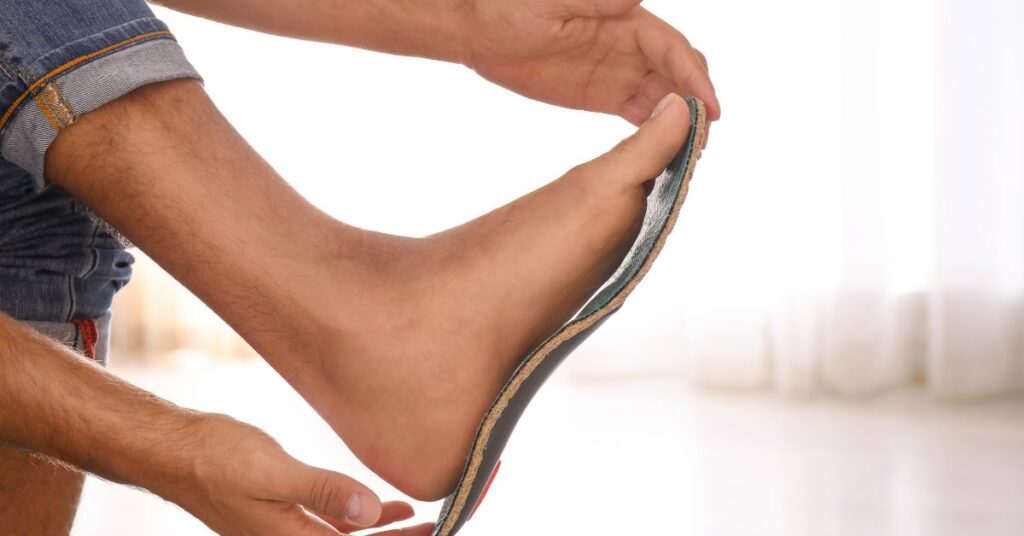
They help spread weight over the foot evenly; hence reducing pressures on the plantar fascia.
However, orthotics are inserts designed by professionals who specialize in identifying particular foot problems that a patient may have developed.
This is done through prescription, which clarifies whether any changes are needed for their feet. This ensures that each abnormality is treated individually, leading to personalized treatment for persons with plantar fasciitis.
Advanced Day 6: Care And Relaxing Massages For The Feet.
Exploring Your Physical Therapy Options
Physical therapy is the best form of treatment for plantar fasciitis. A physical therapist would develop exercises and techniques that will aid in strengthening the foot and lower leg muscles, thereby increasing flexibility and reducing pain. Besides, they may also use modalities like electrical stimulation or ultrasound to ease pain as well as facilitate healing.
Self-Massage Techniques and Tools
Let us now look at self-massage techniques and tools for reducing tension and promoting relaxation in your feet:
- Tennis Ball Massage: Roll a tennis ball under your foot while applying gentle pressure. Concentrate on troubled areas, and breathe deeply during massaging.
- Frozen Water Bottle: Freeze a bottle of water, then use it to rub the bottom part of your leg. Cold temperature reduces inflammation while rolling motion gives a soothing effect.
- Foot Roller: Purchase a foot roller specifically designed to target the arches and heels of your feet. Spend a few minutes every day rolling back and forth to release tension and improve blood circulation.
Medication Day 7 and Beyond
Getting to Know More about Anti-Inflammatories
You can reduce the pain and inflammation caused by plantar fasciitis with anti-inflammatory drugs like Ibuprofen or Naproxen.
These medications work by reducing swelling in the affected area and alleviating discomfort. Nevertheless, they must be used as directed and physicians’ advice must be sought.
What’s Next? Planning
Looking ahead, it is important to continue with the treatment plan that has been effective for you. This may include an ongoing stretching and strengthening program.
Also, the use of supportive footwear or other things that have worked well for you may still be part of your daily routine.
Keep a healthy weight; select supporting shoes and think about orthotic inserts for lasting foot care that will help manage plantar fasciitis in the future too.
Alternative Therapy
Yoga and Acupuncture for Plantar Fasciitis
Practicing yoga which consists of gentle exercises and poses can make the foot more pliable, and stronger while also creating a feeling of relaxation.
These specifically target your plantar fascia muscles and lower leg, therefore reducing plantar fasciitis-related pain.
On the other hand, acupuncture involves an experienced doctor inserting very thin needles into certain parts of your body so as to treat you. It may reduce inflammation and alleviate the pain associated with plantar fasciitis.
Keeping a Foot Care Diary
If you have some issues you should keep a record of how your foot feels each day in a diary. This way, you can record those things that make your foot hurt more and those that make it feel better.
Tracking pain levels helps you comprehend what works best for you and what doesn’t.
Therefore, both you and your healthcare provider will be able to adjust your treatment plans based on this information when selecting interventions designed to improve foot function.
Signs It’s Time to See a Doctor
- Pain in the foot that is severe and does not decrease with treatments that can be applied while at home.
- Foot pain that disrupts your normal activities and does not improve after resting.
- Inflammation, redness, or increased heat on the part affected.
- Continuous discomfort for more than a few weeks even when one tries using some of these home care remedies
- Unable to stand or walk without experiencing pain on the feet.
- Obvious alteration in the form of your heel or foot.
- If you have diabetes or any other medical condition that can develop a foot pain.
Change your Shoes to Prevent and Cure Plantar Fasciitis
Proper shoes are very important in the prevention and control of plantar fasciitis. Supportive, well-padded shoes can offer great relief and support but this is just a single consideration in the whole treatment plan.
The combination of wearing the right type of shoes and undergoing treatments like stretching exercises, and physical therapy as well as taking a rest and caring for one’s feet is important. When selecting shoes to use when you have plantar fasciitis consider the following:
- Arch support: Shoes with quality built arch support should help in distributing your body mass equally across your feet thereby reducing stress on the Plantar Fascia
- Cushioning: Cushioned shoes absorb shock and relieve the heel as well as plantar fascia from any excess pressure.
- Stability: Stable shoes that have a hard counter heel and motion control features are beneficial in avoiding excessive pronation that can worsen plantar fasciitis
- Removable insoles: Shoes with removable insoles allow you to either personalize them or supplement extra reinforcement when required
Similarly, people need also to avoid putting on unsupportive footwear like ballet flats, sandals, high heels, dress shoes, or shoes with flat/thin soles because they lack essential shoe features made from rigid materials. Some top shoe brands for plantar fasciitis are;
- Brooks: these are running shoes that provide enough cushioning
- Asics: offers several stable motion control shoes having excellent arch reinforcements
- New Balance: Provides a variety of shoes with different levels of support and cushioning
- Saucony: Designs shoes with durable, shock-absorbing cushioning and stability features.
FAQs
Can plantar fasciitis go away on its own?
Plantar fasciitis can in some cases disappear on its own when the patient rests, applies ice, and uses shoes with good arch support. However, several persons will continue to suffer from plantar fasciitis for weeks if not months without receiving medical attention.
Is surgery necessary to treat plantar fasciitis?
Only when other treatments fail then doctors consider surgical intervention as a last resort for patients suffering from plantar fasciitis. But most of these conditions do not require going under the knife.
Can plantar fasciitis be caused by wearing the wrong shoes?
Wearing non-supportive or poorly fitting footwear may lead to the onset or aggravation of plantar fasciitis. In order to manage and prevent this condition, one must put on appropriate shoes having good arch supports and cushioning.
Should I continue exercising with plantar fasciitis?
Don’t do exercise like running or jumping. You can do swimming as it does not put additional pressure on your feet.
Can plantar fasciitis recur after successful treatment?
Yes, sad but true. Recurrence of plantar fasciitis is possible especially when factors such as overpronation, tight calf muscles, and inappropriate shoe gear are not addressed.
This could be prevented by utilizing supportive shoes plus orthotics consistently.
How to Cure Plantar Fasciitis in One Week – Last Words
In fact, plantar fasciitis cannot be totally treated within a week but timely and suitable management can really help relieve the symptoms.
The most important thing is to consult professionals for advice and follow an individualized treatment regimen to achieve the best outcome.
Good care including resting, putting on supportive shoes, and doing particular exercises can ensure complete healing over time and reduce its likelihood of coming back.
Sources
https://www.ncbi.nlm.nih.gov/pmc/articles/PMC3954277/
https://www.medicalnewstoday.com/articles/324353
https://www.healthline.com/health/plantar-fasciitis
https://www.versusarthritis.org/media/21790/plantar-exercise-sheet.pdf https://www.ncbi.nlm.nih.gov/books/NBK431073
Read More
10 Best Shoes For Achilles Heel
Top10 Best Shoes For Fallen Arches
Best Women’s Shoes for Flat Feet
10 Best Footwear for Lower Back Pain

Hello everyone, I’m Sammi, a shoe expert in your neighborhood and a health freak.
When I am not running around, I indulge myself in running gear to bring you the best selections. Over the years I have put my feet through numerous miles that taught me a thing or two.
I work with an incredible team of running enthusiasts who enjoy testing out products as much as I do. Think us like Avengers of Running Shoes but with more shoes and fewer capes.
We are responsible for putting each pair to the test so that you can find your perfect match without going through much trouble.
This blog will provide you with direct reviews, funny stories about my running adventures, and useful wellness advice to keep you on the road at all times.
Whether it is preparing for a marathon or starting off your jogging journey; I am here to assist you.
Let’s wear those shoes and take off!


